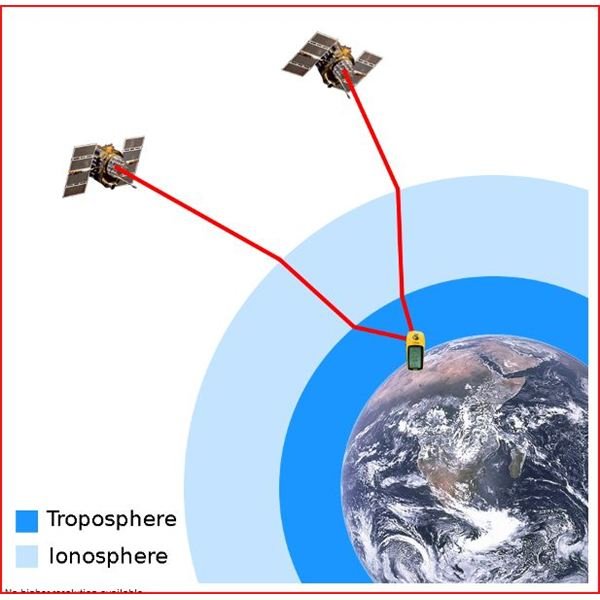GPS Jamming and GPS Spoofing Account for a Big Chunk of the 10 GPS Vulnerabilities
Civilian GPS Signals are Not Secure
Whereas the U.S. military uses GPS signals that are encrypted and require authentication (which protects them more from GPS jamming and spoofing), civilian GPS receivers have no such capabilities. Therefore, the vast majority of civilian GPS receivers, which have a relatively weak signal already, are vulnerable because the antennae can be, for all intents and purposes, shielded from receiving the GPS satellite’s data telling it where it is or be intentionally sabotaged to transmit incorrect information.
Low Frequency Creates the Opportunity for GPS Jamming and GPS Spoofing
The GPS signal strength that is received on Earth is relatively low. So this low powered signal is essentially at the root of the majority of the vulnerabilities we will be discussing in this article. The low signal is more susceptible to all sorts of interference that can degrade and jeopardize its effective strength that is the result of both natural and human activity. A helpful analogy might be to think about how easy it would be for a full-blown symphony to drown out a chirping cricket. Keep this in mind when we cover jamming and spoofing next because then it’s easier to understand why it’s possible. But if you’re interested, some of the more technical aspects are discussed in Enhancing the Code to Measure GPS Strength – Essentials of GPS.
Intentional Jamming
Since GPS signals are low and very sensitive, they’re therefore susceptible to jamming. There are a few hackers’ websites out there describing the technical details about how to build a GPS jammer which could be a particularly nasty threat to the GPS navigation units used in aviation. Essentially, a jammer operates by transmitting static on the GPS receiver’s frequency which effectively overpowers a GPS unit from receiving satellite signals. Apparently, even a very low powered 1 watt jammer can jam receivers in a 100 kilometer radius. You can learn more about this by reading How GPS Signal Jammers Work. The U.S. military is working on sending blocking satellites and increasing the strength of GPS signals that will reduce the potential of interference sometime in the near future.
Unintentional Jamming
Inadvertent jamming may pose an even greater threat, especially to pilots off shore. This is an unintentional consequence of VHF/UHF television antenna preamplifiers on vessels at sea generating a signal which is strong enough to jam a GPS receiver. The jamming radius of an antenna such as that could reach 1 kilometer, while stronger omni-directional antennas have the capacity to interfere with signals at a much greater radius of 50 kilometers. Pilots should therefore never rely exclusively on GPS for navigation due to the risks. Commercial television broadcasts, aeronautical satellite communications, very high-frequency transmitters, military communication systems, Ultra Wide-Band systems, and Mobile Satellite System terminals can also cause unintentional degradation and interference with signals as well. A look at GPS Jamming and the Military will explain how they contend with issues of jamming.
GPS Spoofing: Someone is Making your GPS Tell Lies
Spoofing is the result of malefactors providing fake GPS satellite signals to GPS receivers and this is a very serious concern on our list of the 10 GPS vulnerabilities. Individuals engaging in GPS spoofing deliberately send misleading information which is hoped to misdirect whomever may be using the targeted GPS receiver, be it man or machine, Therefore, the targeted GPS receiver reports that it’s not actually where it’s at and/or displays the incorrect time. This kind of attack is said to be relatively easy, the saboteur doesn’t even have to know all that much about GPS technology. And we’ve already pointed out that the GPS infrastructure the public uses is not secure; which opens the door for persons with bad intentions. Fortunately, the U.S. Government’s Vulnerability Assessment Team (VAT) at Los Alamos National Laboratory does provide GPS spoofing countermeasures which you can learn about here at homelandsecurity.org. These countermeasures have no way of detecting spoofing attacks, but the information there contains some proposals for modifying receivers so it would be more difficult to spoof them. By the same token, the military necessarily has to train for all sorts of scenarios, which include jamming and spoofing tests which could feasibly interfere with the entire GPS enchilada which everyone else relies on for navigational sustenance. So that ends our comprehensive list of 10 GPS vulnerabilities. If you happened to land on this article, be sure and check out the first in this series (covering 1-5), by clicking on the link below.
Sources
https://www.ne.anl.gov/capabilities/vat/spoof.html
This post is part of the series: Ten of the Top Vulnerabilities and Threats to GPS Technology
The 10 GPS vulnerabilities are divided into two articles here to cover the full scope of what is at stake or at risk in terms of global positioning systems from receivers to satellites. We’ll cover GPS jamming and GPS spoofing plus 8 other intriguing and viable threats to our navigational systems.
